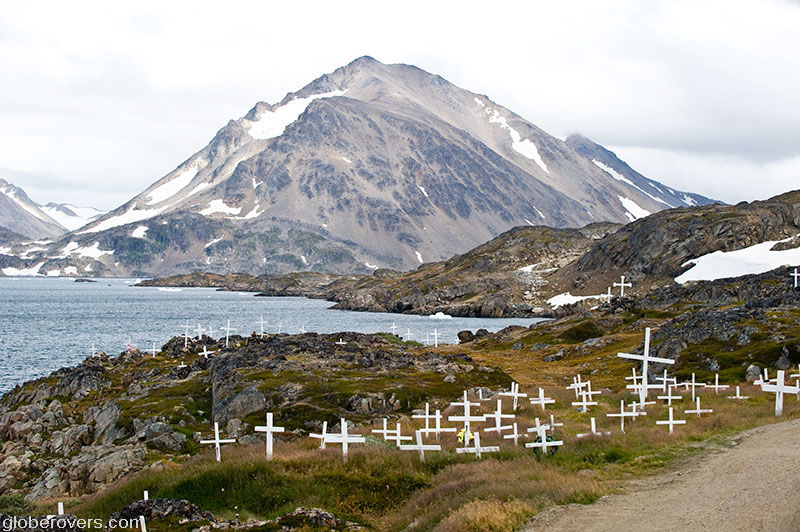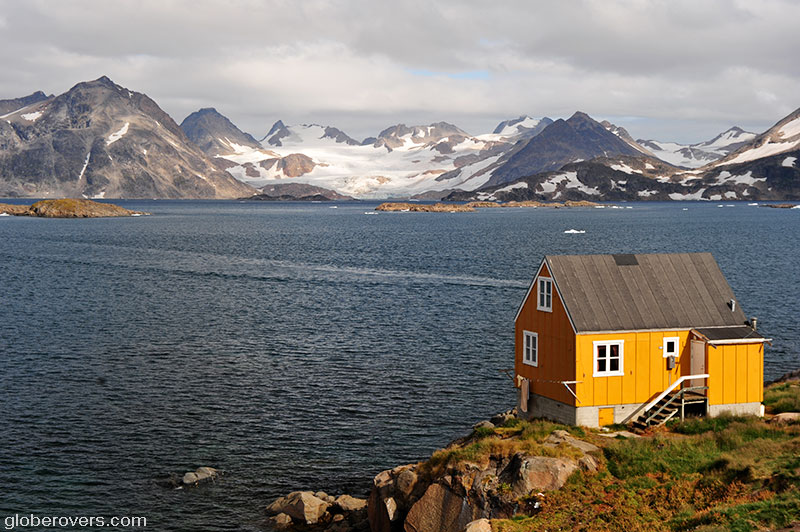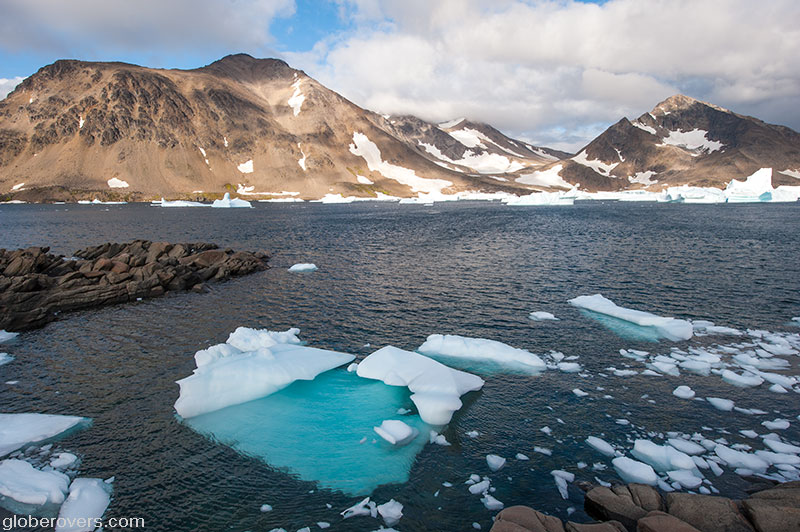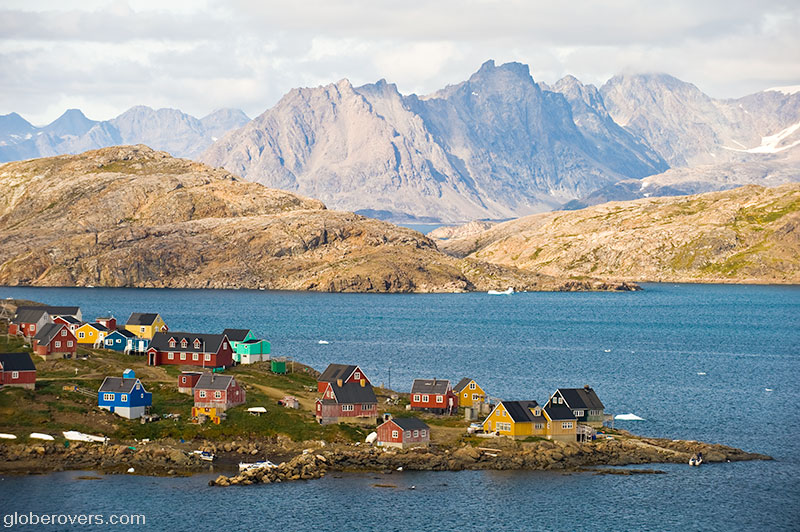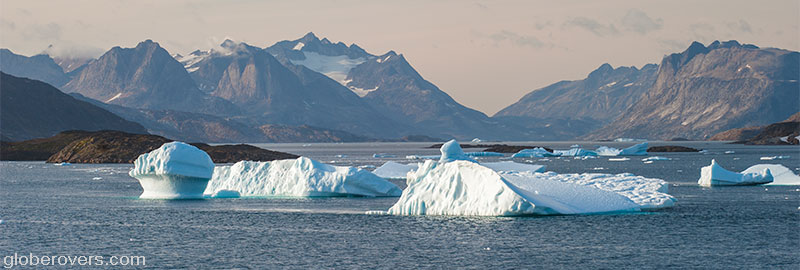
As the gateway to eastern Greenland, Kulusuk is a small settlement of 300 souls, located in the Ammassalik region. Kulusuk is situated on a small rocky island between jagged mountains and extensive fjords, and is most of the time surrounded by icebergs and a glittering sea of ice.
Traditional hunting and fishing still remain a vital source of income for the few families living here.
Why travel to Kulusuk in Greenland?
- The low-down: Kulusuk is one of the most remote villages along the coast of Greenland. The small population of Inuits are not exactly friendly, but nature makes the visit an unforgettable experience.
- The brightest highlight: The colourful village, often surrounded by floating icebergs, with a backdrop of glacier-covered mountains – a beautiful sight indeed.
- Intrepid destination: Absolutely. The village only has one small hotel, which is quite expensive. You won’t run into many travellers here!
- Globerovers score (10 is highest): An incredibly beautiful part of the world. It gets a score of 9/10.

Table of Contents
Highlights of Kulusuk
1. Kulusuk settlement
This small colourful settlement with about 300 inhabitants is located in a beautiful setting surrounded by snow-capped mountains and drifting icebergs.
2. Colourful cemetery
Just outside the village is a collection of small white crosses with most graves entirely covered in very colourful artificial flower decorations.
3. Icebergs and green hills in summer
All around is water with drifting icebergs. The surrounding hills are covered in northern black crowberries, arctic cottongrass, mushrooms, and lush green moss.
4. Song and dance
A local Inuit man does his song and drum dance about the eagle and the bear while beating his bearskin drum and wearing his bearskin boots.
5. Glaciers and islands
A short small boat ride away goes to glaciers and the many surrounding islands, including the nearby village of Tasiilaq which can also be reached by helicopter.
The world’s biggest island
Greenland should be every intrepid traveller’s dreamland. This rugged island of ice and rocks has almost no boundaries to the true adventurer.
Located between the Arctic and the Atlantic Oceans, east of the Canadian Arctic Archipelago, Greenland was ceded from Norway to Denmark in 1814 and is currently an autonomous country within the Kingdom of Denmark.
According to Inuit culture in Greenland, a person possesses six or seven souls. The souls take the form of tiny people scattered throughout the body…
While it is the world’s biggest island, over three-quarters of its surface is covered by the only contemporary ice sheet outside of Antarctica. It has a coastline (39,330 km / 24,440 mi) about the same length as the Earth’s circumference at the equator. The highest point is at 3,859 m (12,660 ft) while the majority of the island is under 1,500 m (5,000 ft) elevation.
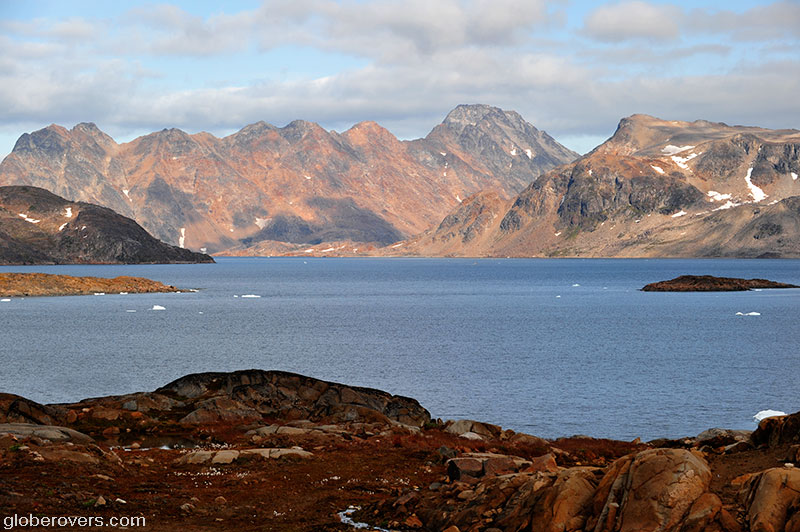
Although much of Greenland is covered by a massive ice sheet, most of the extreme northern part is not covered by any ice as the air is too dry to produce any significant snow-falls.
Some scientists believe that if Greenland’s ice sheet was to melt away completely, the world’s sea level would rise by more than 7 m (23 ft) and what would remain of Greenland would be just a few thousand islands. What would remain of some countries and many islands around the world would be, nothing!
The few settlements on Greenland are remotely tucked away along the many scattered islands at the periphery of the main island.
With such a vast area and only about 56,400 inhabitants, it is also the world’s least densely populated country.
The first inhabitants moved here from Canada about 4,500 years ago and later some Norsemen (Old Norse-speaking tribes) settled in the south during the 10th century while the Inuit peoples arrived in the 13th century.
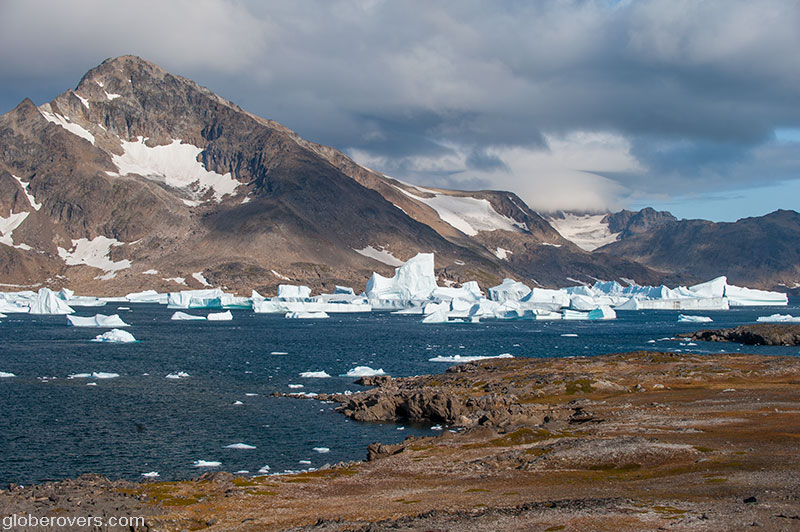
Today the vast majority of Greenland’s inhabitants are Greenlandic Inuit and European mixed, while about 10% are Europeans – mainly Danish.
The largest town, Nuuk on the southwest coast, has about 16,500 residents while the second largest, Sisimiut to the north, has just about 6,000 residents.
While most of Greenland is ice all year round, during the summers the peripheral area and islands are green, with floating icebergs visible in all directions.
The top six most populated towns are all on the west coast. Head over to the east coast where the largest town, Tasiilaq, has about 2,000 residents. A 10-minute helicopter ride to the west is the small village of Kulusuk. In summer it is cheaper to take a boat, while in winter a dogsled ride to Tasiilaq is a great experience.
Kulusuk village
This lonely village on the southeast coast of Greenland had a population of about 350 in 1998 but only about 300 remained in 2013.
The population has decreased by 23% relative to the 1990 levels, and by over 19% relative to the 2000 levels. Where have the people gone?
The decline is due to emigration, as natural growth is positive.
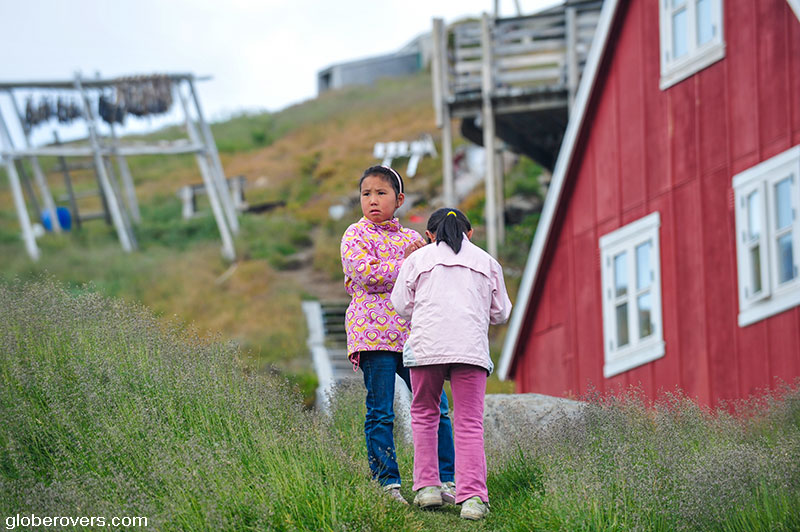
Winters are harsh, long and dark, with the ice and snow up to gigantic levels. The east coast is also significantly windier than the west coast, in particular the persistent northeasterly winds from the Greenland Sea.
Summers are short but can be very pleasant. Arrive here between late June and end of September and you will find warm sunny days with little wind. While most of Greenland is ice all year round, during the summers the peripheral area and islands are green, with floating icebergs visible in all directions.
Facilities in the village are limited to a small school, clinic, post office and the popular Pilersuisoq shop, which is a chain of all-purpose general stores found in Greenland’s towns.
The church in the village was constructed in 1908, one year before the village was founded in 1909, by the crew of a Danish sailing vessel that ran aground here. The church was constructed from the timbers of the ship itself. A model of the ship is on display in the front left side of the church.
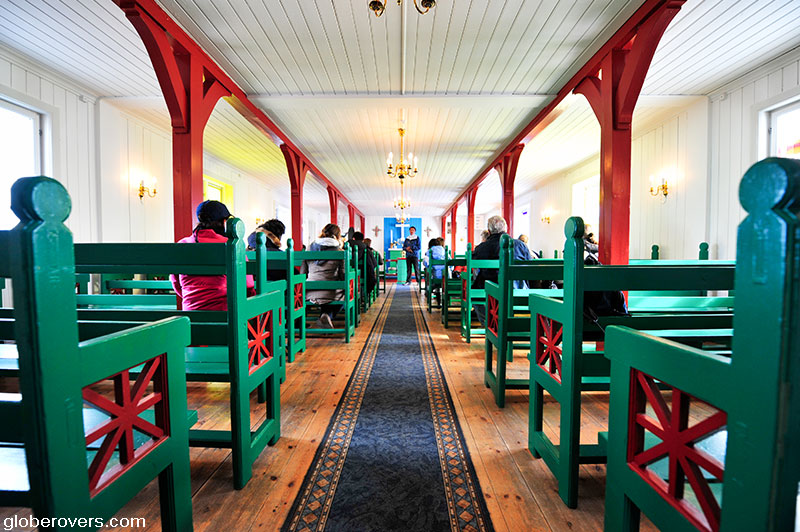
In the village is a small shop that sells products by local craftsmen who use animal horns, bone and teeth to create intricate art pieces called Tupilaks. The items are of superior quality, well displayed, and expensive. Part of the shop building also houses a small local museum.
A local Inuit man often treats the few tourists outside the museum to his song and drum dance. While he speaks and sings no English, his favourite folk song is about the eagle and the bear. He also likes to engage his small audience in his dancing while beating his bearskin drum and wearing his bearskin boots.
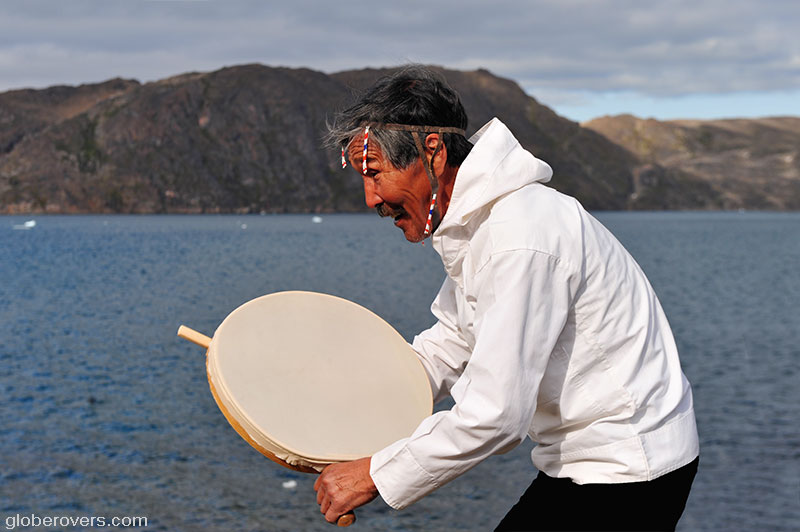

A couple of tourists arrive here daily from Reykjavik in Iceland on a scheduled Air Iceland turboprop plane. From Kulusuk it is possible to transfer to nearby Tasiilaq village by helicopter which is only about 10 minutes away. In summer, small boats travel between the two villages, while in winter taking huskie dogs with a sled is the only option.
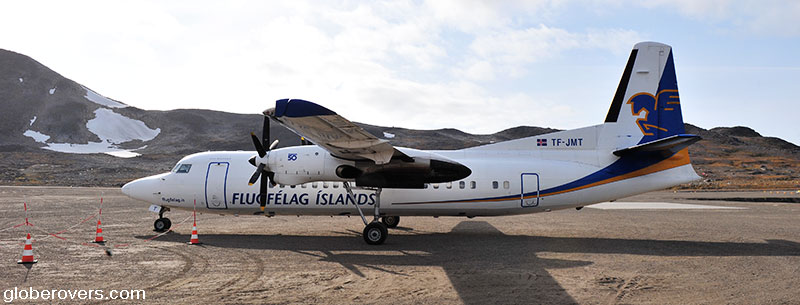
Hotel Kulusuk, the only hotel in the area, lies halfway between the village and the airport and provides superb services to travellers. The hotel is walking distance from both the airport and the village and is located close to the sea.

Around town are several husky dogs and even a domesticated wolf, all on leashes. These dogs are used for sledding, the main form of transportation during the snowy winter months.
The local Inuit people speak Kalaallisut (West Greenlandic) which is closely related to the Inuit languages in Canada, such as Inuktitut. Kalaallisut has been the official language of the Greenlandic autonomous territory since June 2009 although other dialects are being spoken across Greenland such as East Greenlandic (Tunumiisut) and the Thule dialect Inuktun. Some people in Kulusuk speak a little English.
The main activity around Kulusuk is to explore the area on foot. Many floating icebergs create great photo opportunities. During autumn the hills are covered in northern black crowberries (empetrum nigrum), arctic cottongrass (eriophorum), mushrooms, and lush green moss.
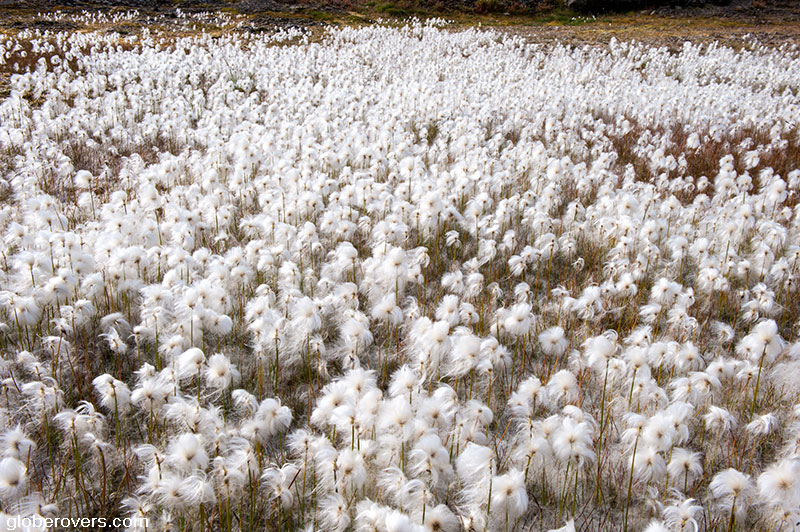
The village is pleasant, although the locals keep to themselves and don’t seem to be over-excited to see a foreigner wandering around with a big camera.
The Kulusuk cemetery just outside the village on the southern and northern slopes of a small hill is a collection of small white crosses. Most graves are entirely covered in very colourful artificial flower decorations. No names of the deceased appear on the crosses in honour of the Inuit tradition that the names are passed on to another at death and lives on to the next generation. These colourful graves against the backdrop of snowcapped mountains are quite a sight.
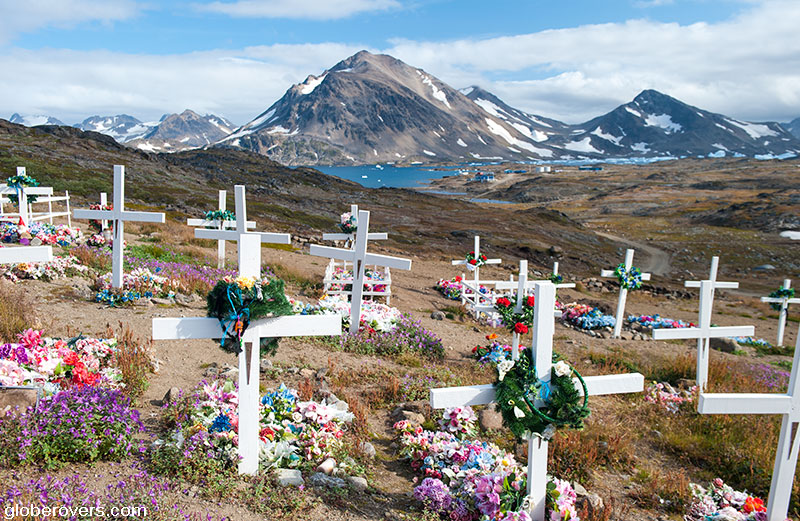
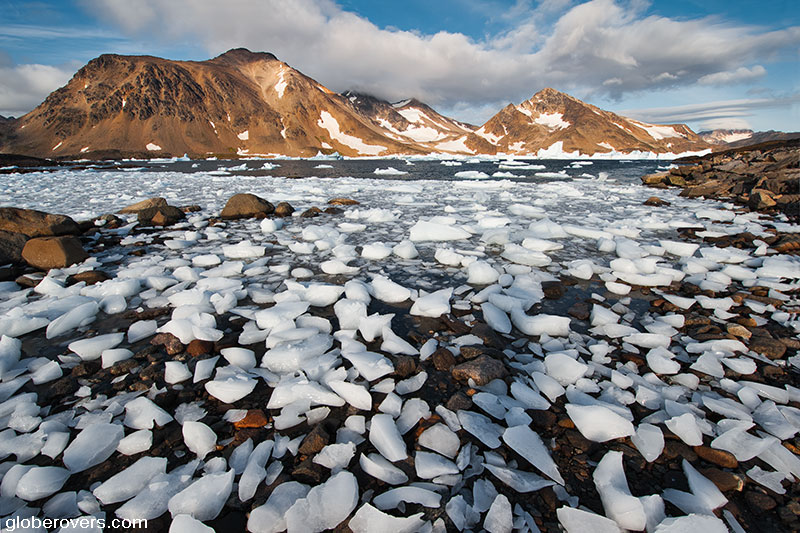
Kulusuk and its surroundings offer much to see. Fresh fresh air, beautiful mountains, icebergs, fresh wild blackberries, birds, and the local Inuit people. Greenland to me was without a doubt, one of my most amazing experiences!
Essential Information
Getting There
Kulusuk is on the east coast of Greenland and just a two-hour flight from Reykjavik, Iceland, on the turboprop plane of Air Iceland Connect. Another option is to fly on Air Greenland from Denmark. Currently, there is no ferry between Iceland and Greenland.
When to Go
Winters are cold and snowy so arrive here between late June and the end of September and you will find warm sunny days with little wind.
Getting Around
When the waters are not frozen and the husky dog sleds are grounded, the best way to get around is on foot, by boat, or by helicopter to the nearby glaciers and the village of Tasiilaq.
Where to Stay
The only option currently is Hotel Kulusuk. This small, fairly new, and expensive hotel is located halfway between the village and the airport. It provides superb services and food to weary travellers.
Cost of Travel
Travelling to Greenland is expensive. A return ticket on Air Iceland from Reykjavik in Iceland costs between €600 and €800 and must be booked long in advance. A small single room at Hotel Kulusuk is €140 while a double is €180, including a very good breakfast. Local boat trips with the Inuit people are not cheap either as they easily charge €30 to €50 for a short ride. Cost updated in March 2020.
☛ Read more: Blog posts of Glaciers

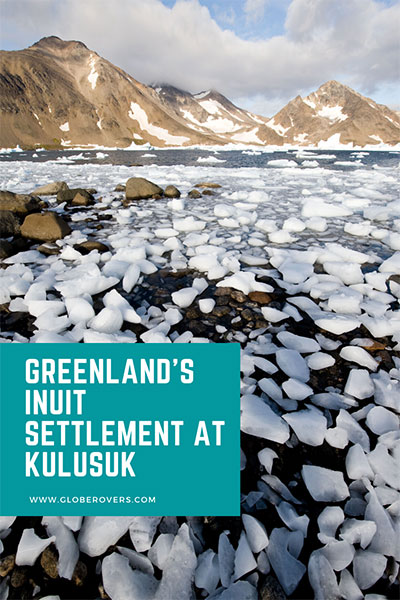
Further reading
- 12 places to visit in Iceland
- A day in Kulusuk
- Everything You Need to Know About Visiting Greenland From Iceland

Blog post and photos by Peter who has been travelling almost full-time since 2005 and has been to over 122 countries. He visited several countries, such as Japan, more than 20 times. Peter is Editor-in-Chief and Publisher of GlobeRovers Magazine, an independent travel magazine focused on intrepid destinations.

